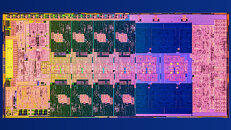- Joined
- Oct 9, 2007
- Messages
- 47,656 (7.43/day)
- Location
- Dublin, Ireland
| System Name | RBMK-1000 |
|---|---|
| Processor | AMD Ryzen 7 5700G |
| Motherboard | Gigabyte B550 AORUS Elite V2 |
| Cooling | DeepCool Gammax L240 V2 |
| Memory | 2x 16GB DDR4-3200 |
| Video Card(s) | Galax RTX 4070 Ti EX |
| Storage | Samsung 990 1TB |
| Display(s) | BenQ 1440p 60 Hz 27-inch |
| Case | Corsair Carbide 100R |
| Audio Device(s) | ASUS SupremeFX S1220A |
| Power Supply | Cooler Master MWE Gold 650W |
| Mouse | ASUS ROG Strix Impact |
| Keyboard | Gamdias Hermes E2 |
| Software | Windows 11 Pro |
Intel introduced a line of 14th Gen Core "Raptor Lake Refresh" Socket LGA1700 processors for the embedded systems market. A highlight of these chips is that they come with their "Gracemont" E-core clusters disabled, and are pure P-core chips. It's interesting that Intel targets these chips for the embedded systems segment, but isn't building these in the non-socketed BGA packages carried over from its mobile platforms. Intel is addressing nearly all performance market-segments with these chips, including the very top. The Core i9-14901KE processor leading the pack is an 8-core/16-thread chip with eight "Raptor Cove" cores sharing the full 36 MB L3 cache available on the "Raptor Lake-S" die, a maximum boost frequency of 5.80 GHz, base frequency of 3.80 GHz, and processor base power of 125 W. The chip features an iGPU. The "K" in KE denotes that the chip supports overclocking.
Next up, is the Core i9-14901E, the 65 W sibling of this chip, which lacks an unlocked multiplier, and boosts up to 5.60 GHz, with a 2.80 GHz base frequency. Things get interesting with the Core i7-14701E, because the differentiator between the Core i9 and Core i7 SKUs is E-core count, and here we see the i7-14701 retaining the same 8-core/16-thread pure P-core configuration as the Core i9 chips, but with a touch lower frequencies of 5.40 GHz maximum boost, and 2.60 GHz base.

The Core i5-14501E is a 6-core/12-thread processor based on the larger "Raptor Lake-S" die, unlike the regular Core i5-14500 that uses the "Alder Lake-S" die. The 6 P-cores share 24 MB of L3 cache, and each feature 2 MB of dedicated L2 cache, unlike the i5-14500, which sees 1.25 MB of L2 cache per P-core, besides the 8 E-cores. This chip boosts up to 5.20 GHz, and has a base frequency of 3.30 GHz. The i5-14501TE is a variant of this chip with 45 W processor base power, 5.10 GHz maximum boost frequency, and 2.20 GHz base frequency.
Lastly, there are the Core i5-14401E, i5-14401EF, and the i5-14401TE. The first two are differentiated with the i5-14401EF lacking integrated graphics, the first two are 65 W chips, while the i5-14401TE is 45 W. The i5-14401E/EF boost up to 4.70 GHz, with a 2.50 GHz base frequency, while the i5-14401TE boosts up to 4.50 GHz, with a 2.00 GHz base frequency.
All chips in the 14th Gen Core E-series feature the same I/O as the regular 14th Gen Core desktop processors, with a PCI-Express 5.0 x16 PEG interface, a CPU-attached Gen 4 x4 NVMe interface, and a DMI 4.0 x8 chipset bus. The memory interface supports dual-channel DDR4 and DDR5 memory types.
View at TechPowerUp Main Site | Source
Next up, is the Core i9-14901E, the 65 W sibling of this chip, which lacks an unlocked multiplier, and boosts up to 5.60 GHz, with a 2.80 GHz base frequency. Things get interesting with the Core i7-14701E, because the differentiator between the Core i9 and Core i7 SKUs is E-core count, and here we see the i7-14701 retaining the same 8-core/16-thread pure P-core configuration as the Core i9 chips, but with a touch lower frequencies of 5.40 GHz maximum boost, and 2.60 GHz base.

The Core i5-14501E is a 6-core/12-thread processor based on the larger "Raptor Lake-S" die, unlike the regular Core i5-14500 that uses the "Alder Lake-S" die. The 6 P-cores share 24 MB of L3 cache, and each feature 2 MB of dedicated L2 cache, unlike the i5-14500, which sees 1.25 MB of L2 cache per P-core, besides the 8 E-cores. This chip boosts up to 5.20 GHz, and has a base frequency of 3.30 GHz. The i5-14501TE is a variant of this chip with 45 W processor base power, 5.10 GHz maximum boost frequency, and 2.20 GHz base frequency.
Lastly, there are the Core i5-14401E, i5-14401EF, and the i5-14401TE. The first two are differentiated with the i5-14401EF lacking integrated graphics, the first two are 65 W chips, while the i5-14401TE is 45 W. The i5-14401E/EF boost up to 4.70 GHz, with a 2.50 GHz base frequency, while the i5-14401TE boosts up to 4.50 GHz, with a 2.00 GHz base frequency.
All chips in the 14th Gen Core E-series feature the same I/O as the regular 14th Gen Core desktop processors, with a PCI-Express 5.0 x16 PEG interface, a CPU-attached Gen 4 x4 NVMe interface, and a DMI 4.0 x8 chipset bus. The memory interface supports dual-channel DDR4 and DDR5 memory types.
View at TechPowerUp Main Site | Source






